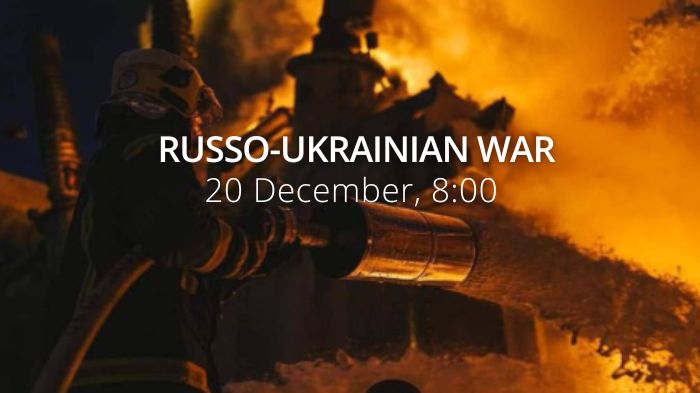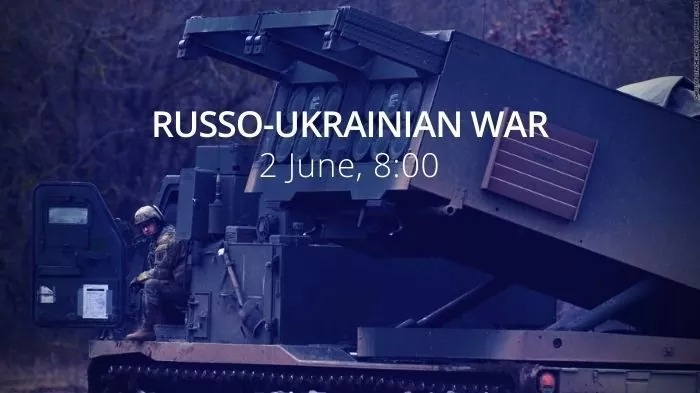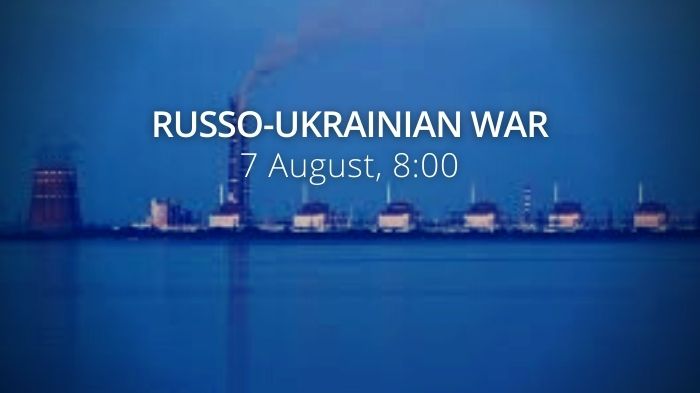Ukraine explores options for a special tribunal to prosecute Russia. Ukrainian Defence Forces down 30 Shahed drones overnight. Russia gets another 250 Shahed UAVs from Iran.
Daily overview — Summary report, December 20
A map of the approximate situation on the ground in Ukraine as of 00:00 UTC 20/12/22.
There have been no notable changes to control since the last update. pic.twitter.com/FW76vk7aYj
— War Mapper (@War_Mapper) December 20, 2022
The General Staff’s operational update regarding the Russian invasion as of 06.00 am, December 20, 2022 is in the dropdown menu below:
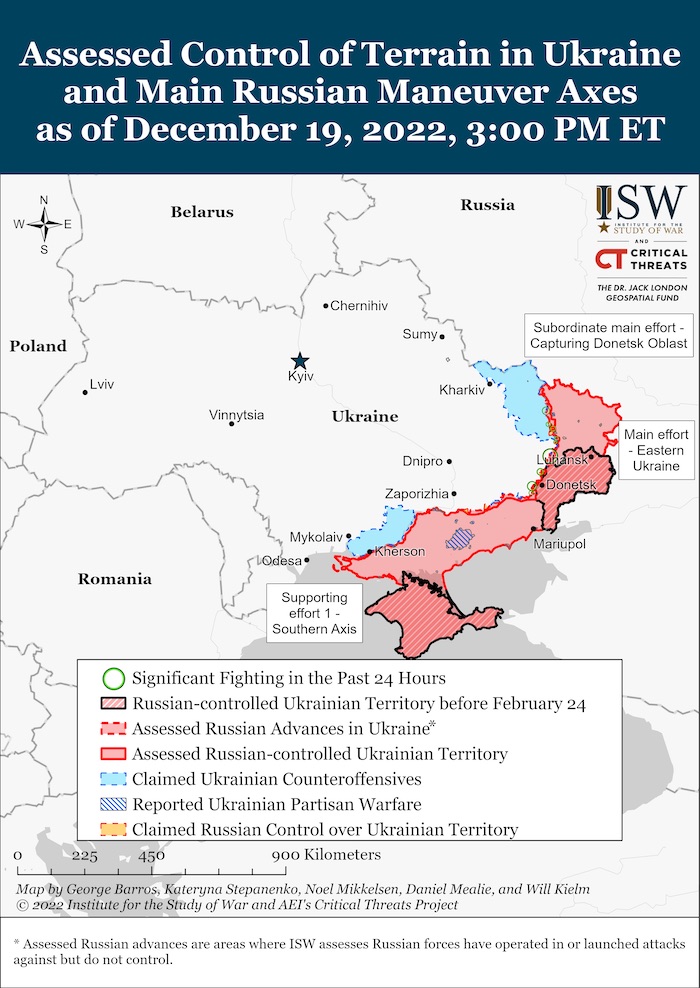
Russian forces continue to focus their efforts on conducting offensive actions in the Bakhmut and Avdiivka directions. It is trying to restore the lost position in the Lyman direction and conducts defence in other directions.
Over the past day, units of the Defense Forces of Ukraine repelled the attacks of the occupiers in the areas of the settlements of Stelmakhivka, Chervonopivka, and Serebryanske of the Luhansk region, and Verkhnyokamianske, Pidhorodne, Bakhmut, Opytne, Kurdyumivka, Krasnohorivka, and Mariinka of the Donetsk region.
During the day, Russian forces carried out 4 missile and 60 airstrikes and also carried out more than 80 MLRS attacks. As a result of these strikes, civilian infrastructure and the population was affected.
[Russian forces also used 28 Iranian Shahed-136 attack UAVs, 23 of which were shot down by the Defense Forces of Ukraine. As a result of enemy strikes, civilian infrastructure and the civilian population were damaged.]
The threat of enemy air and missile strikes on critical infrastructure remains throughout Ukraine.
In the Volyn and Polissya directions, the situation remains without significant changes, no signs of the formation of offensive groups of occupiers have been detected. Certain units of the armed forces of the Republic of Belarus and the Russian Federation continue to be located in the border areas with Ukraine.
- On the Siverskyi direction, the settlements of Tymonovychi, Karpovychi and Kostobobriv of Chernihiv oblast and Novovasylivka, Kindrativka, Vodolaghy, Zapsillia and Yizdetske in Sumy oblast were hit by mortar attacks.
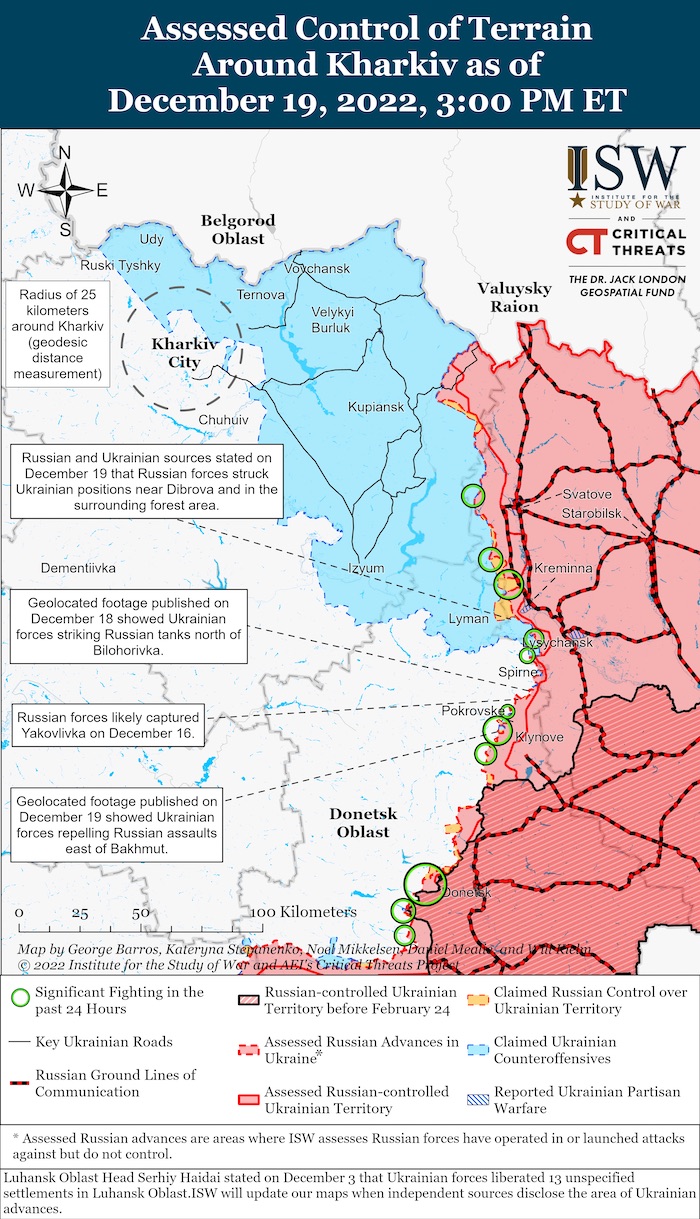
- In the Slobozhansk direction, the enemy carried out mortar and artillery attacks on the positions of our troops in the areas of the settlements of Strilecha, Hlyboke, Starytsa, Vovchansk, Volokhivka, Chuhunivka, and Dvorichna of the Kharkiv oblast.
- On the Kupiansk and Lyman directions, the enemy fired tanks, mortars, artillery and MLRS on the areas of the settlements of Kotlyarivka, Krokhmalne, Berestove in the Kharkiv oblast and Novoselivske, Stelmakhivka, Makiivka, Ploshchanka, Chervonpopivka and Dibrova in the Luhansk oblast.
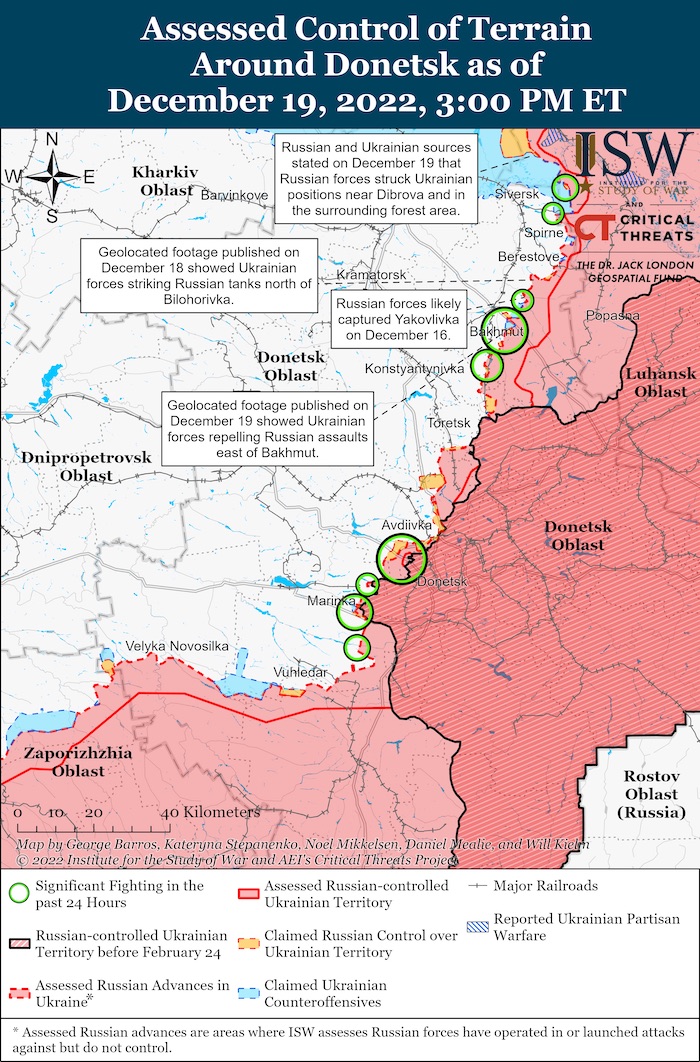
- In the Bakhmut and Avdiivka directions, the enemy continues to conduct assaults, fired tanks, mortars and MLRS at our positions in the areas of thirty settlements. In particular, these are Verkhnokamianske, Berestove, Yakovlivka, Soledar, Hryhorivka, Bakhmutske, Bakhmut, Chasiv Yar, Klishchiivka, Andriivka, Kurdyumivka, Avdiivka, Krasnohorivka, Mariinka, and Novomykhailivka of the Donetsk oblast.
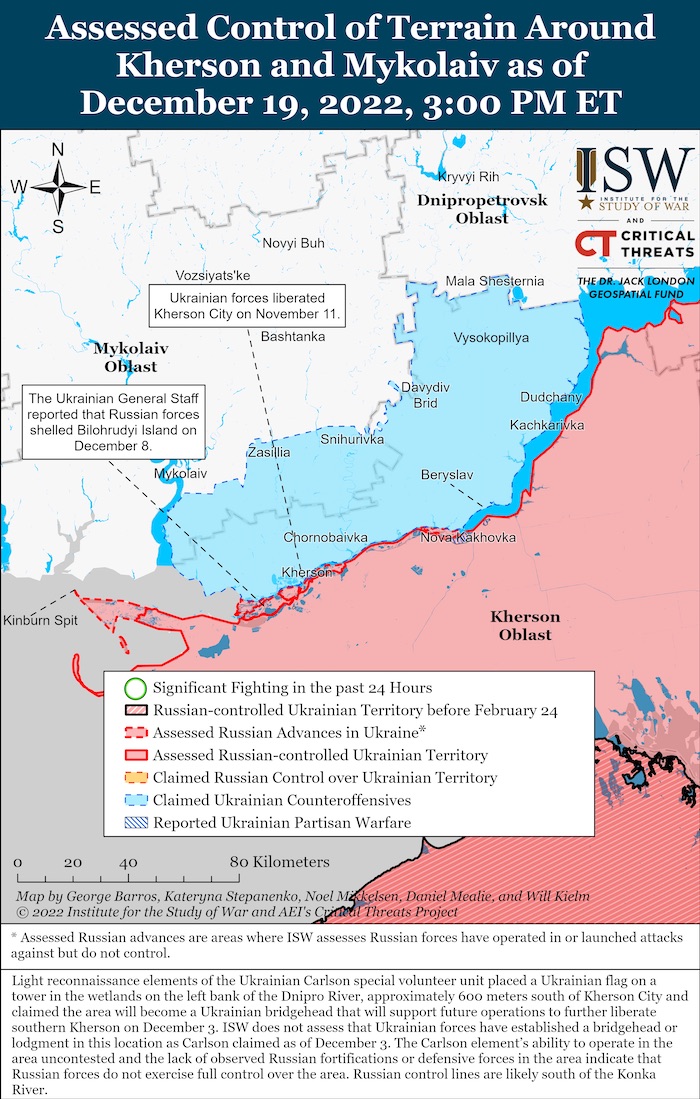
- In the Zaporizhzhia and Kherson directions, the enemy continues artillery shelling of the positions of our troops and civilian infrastructure along the right bank of the Dnipro River. The areas of Temyrivka, Chervone, Mali Shcherbaky and Plavni settlements in the Zaporizhzhia oblast and Chornobayivka, Antonivka, Kherson, Mykilske, Tokarivka and Mylove in the Kherson oblast were affected..
Russian forces continue to suffer losses, it was confirmed that the Russian permanent deployment point was hit on December 18 in the area of Chaplinka, Kherson region. Information about the dead and wounded occupiers is being clarified.
[Due to the significant losses of the invaders, the repurposing of hospitals in the temporarily occupied territories of Luhansk oblast into military hospitals continues. Thus, the Luhansk Oblast Clinical Hospital, the Luhansk City Multidisciplinary Hospital No. 15 and the Railway Hospital were handed over for use by the Russian occupation forces. The local population is refused service and suggested to turn to other medical institutions.]
[In the previous days, in the districts of Berdiansk, Tokmak and Polohy of the Zaporizhzhia oblast, an ammunition depot, about 15 units of military equipment of various types were destroyed and more than 150 servicemen of the Russian occupation forces were injured.]
The Ukrainian aviation made 16 strikes on the areas of concentration of personnel, weapons and military equipment and 6 strikes on the positions of Russian anti-aircraft missile systems. Air defence forces shot down two enemy helicopters last day.
Units of the missile troops and artillery of the Defense Forces of Ukraine hit the ammunition depot, 3 control points and 3 areas where Russian manpower was concentrated.”
Military Updates
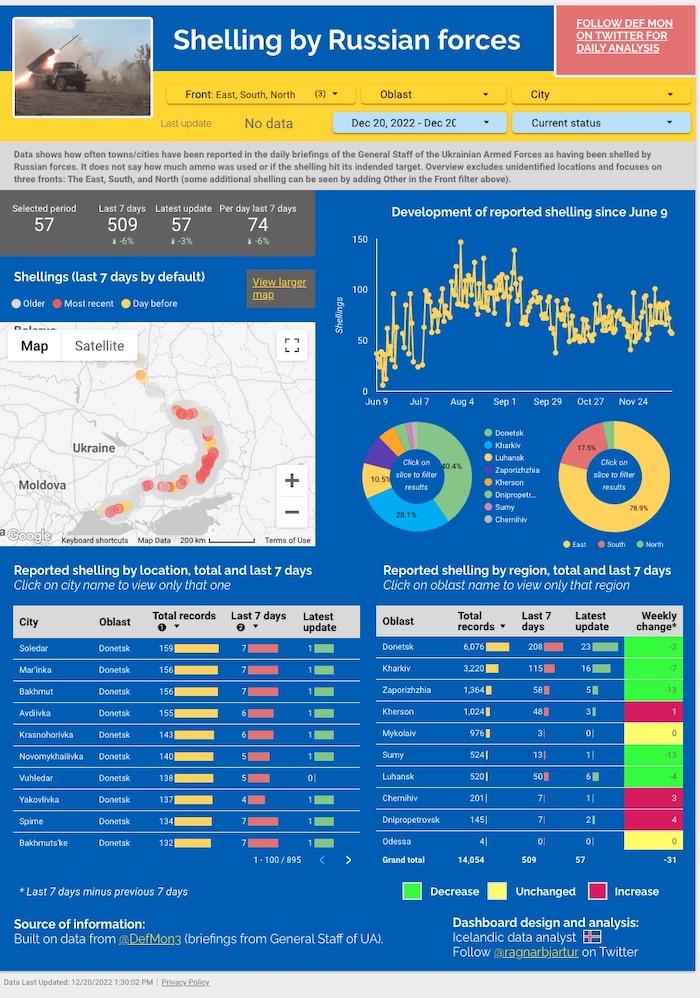
Ukrainian border guards comment on the situation on the border with Belarus, Ukrainska Pravda reports, citing Andrii Demchenko, spokesperson for the State Border Guard Service of Ukraine. "As is known, the Ministry of Defence of Belarus announced the completion of a sudden check of the troops combat readiness that lasted for several days. At the same time, we have not detected any increase in the number of equipment and military personnel or the military manoeuvres during these days. […]
We must be ready for any scenario: for Russian forces trying to enter [Ukraine] from there for the second time, or for Belarusian forces openly supporting the military aggression against Ukraine under Russia’s pressure."
According to Demchenko, apart from strengthening the border in terms of engineering works, Ukrainian forces are destroying all possible routes for military equipment, including placing mines on the most dangerous routes. Moreover, the Ukrainian troops are deploying monitoring systems and using UAVs to observe the situation on the border.
Powerful electronic warfare systems are being used within Belarus to make it difficult for Ukraine to monitor the situation on the border, as well as to launch provocations against the Armed Forces of Ukraine.”
https://twitter.com/EuromaidanPress/status/1604855130918359040
Ukraine’s Armed Forces hit two helicopters and two Russian command posts – General Staff report, Ukrainska Pravda reports, citing the General Staff. “During the day of 19 December, on the 299th day of the full-scale invasion by Russia, Ukrainian fighters carried out 17 airstrikes against the Russian military, shot down 2 helicopters, hit an ammunition storage point, 2 command posts and 2 clusters of Russian military personnel.”
Ukrainian Defence Forces down 30 Shahed drones overnight, Ukrainska Pravda reported Monday, citing the Ukrainian Air Force Command. “Russian occupation forces attacked Ukraine with Iranian-made Shahed-136/131 kamikaze drones on the night of 18-19 December, 30 of which were destroyed by the Defence Forces of Ukraine.”
https://twitter.com/EuromaidanPress/status/1604960263920160768
According to British Defence Intelligence, (last 48 hours):
https://twitter.com/DefenceHQ/status/1605156367916060673
- On 16 December, Russian President Vladimir Putin visited the Joint Headquarters of the Special Military Operation.
- Putin was filmed meeting with a number of senior military officers including Chief of General Staff Valery Gerasimov and Defence Minister Sergey Shoygu. He invited proposals for next steps of the Special Military Operation. Commander of the Russian Group of Forces in Ukraine, General Sergey Surovikin, was one of those who presented a report.
- In this choreographed meeting, Putin likely intended to demonstrate collective responsibility for the special military operation. This display likely aimed to deflect Putin’s responsibility for military failure, high fatality rates and increasing public dissatisfaction from mobilisation. The televised footage was probably designed to also dispel social media rumours of General Gerasimov’s dismissal.
- Russian military proxy group Wagner continues to take a major role in attritional combat around the Donetsk Oblast town of Bakhmut. In recent months, it has developed offensive tactics to make use of the large number of poorly trained convicts it has recruited.
- Individual fighters are likely issued a smart phone or tablet which shows the individual’s designated axis of advance and assault objective superimposed on commercial satellite imagery. At platoon level and above, commanders likely remain in cover and give orders over radios, informed by video feeds from small uncrewed aerial vehicles (UAVs).
- Individuals and sections are ordered to proceed on the preplanned route, often with fire-support, but less often alongside armoured vehicles. Wagner operatives who deviate from their assault routes without authorisation are likely being threatened with summary execution.
- These brutal tactics aim to conserve Wagner’s rare assets of experienced commanders and armoured vehicles, at the expense of the more readily available convict-recruits, which the organisation assesses as expendable.
Losses of the Russian army
As of Tuesday 20 December, the approximate losses of weapons and military equipment of the Russian Armed Forces from the beginning of the invasion to the present day:
- Personnel – about 99230 (+430),
- Tanks – 2995 (+7),
- Armoured combat vehicles – 5974 (+5),
- Artillery systems – 1960 (+7),
- Multiple rocket launchers –MLRS - 410 (+0),
- Air defence means – 212 (+1),
- Aircraft - 281 (+0),
- Helicopters - 266 (+2),
- Automotive technology and fuel tanks – 4599 (+7),
- Vessels/boats - 16 (+0),
- UAV operational and tactical level – 1680 (+23),
- Special equipment – 177 (+2),
- Mobile SRBM system – 4 (+0),
- Cruise missiles – 653 (+0)
Russians pass limit in terms of missile use norms, 3 to 4 more attacks and there will be nothing left, Ukrainska Pravda reports. “Oleksii Danilov, the Secretary of the National Security and Defence Council of Ukraine, believes that the Russians have enough stockpiles of missiles for three to four attacks, but after that they will run out of all stocks, which is unacceptable for the military."
Russia gets another 250 Shahed UAVs from Iran, Ukrainska Pravda reports, citing Office of the President of Ukraine. “President Volodymyr Zelenskyy has stated that the Russian Federation received a new batch of Iranian-made drones; the occupiers have received 250 Shahed UAVs in total.”
Armed convicts desert Russian Army in Mariupol, Ukrainska Pravda reports, citing Pavlo Andriushchenko, Adviser to the Mayor of Mariupol. “In Mariupol the Russians are searching for deserters from the number of recruited convicts, who ran away carrying weapons.”
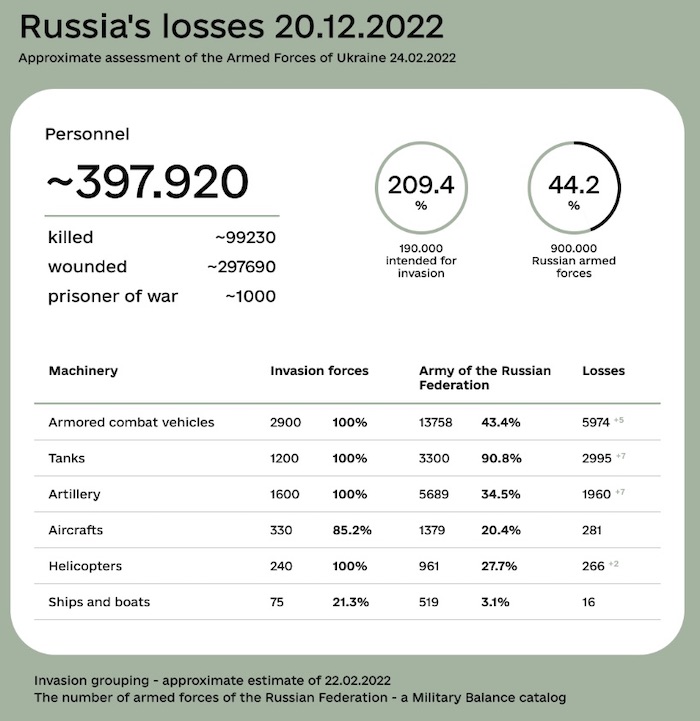
Humanitarian
https://twitter.com/EuromaidanPress/status/1604896090813132800
Situation in power system is "difficult", power outages may be prolonged, Ukrainska Pravda reports, citing the Press service of Ukrenergo, the Ukrainian national energy company. “A difficult situation has developed in the Ukrainian energy system as of 11:00 on Monday, 19 December. Emergency power outages continue in 10 oblasts. […]
Currently, the most difficult situation has developed in the central, eastern and Dnipro oblasts. Emergency power outages schedules have been introduced in Sumy, Kharkiv, Poltava, Dnipropetrovsk, Zaporizhzhia, Kirovohrad, Zhytomyr, Chernihiv, Cherkasy, and Kyiv oblasts and the city of Kyiv.
The critical infrastructure facilities are prioritised for connection. However, Ukrenergo warns that restoring electricity to household consumers may take a long time.”
Ten-hour blackouts Kyiv’s new realities – operator, Ukrinform reports, citing Yasno operator CEO, Serhii Kovalenko. "The situation in Kyiv is difficult. Today, all three groups of consumers are almost completely disconnected from supplies simultaneously. The schedules naturally aren’t working at the moment. In addition to all the damaged sites, where repairs are ongoing, another infrastructure object was hit, due to which there is no power for a large part of the Dnipro’s right bank in Kyiv and some locations across the region. All districts are suffering in the same way. Now all critical infrastructure – hospitals, water utility objects, and subway – has been restored and there is electricity for somewhere around 20% of the population," CEO wrote.
According to Kovalenko, 10 hours without electricity in Kyiv is, unfortunately, a new reality. It is difficult to predict how quickly we will return to stabilization schedules. Energy repair teams at all levels simply don’t make it on time to restore the functionality of the system in-between the strikes, he noted.”
Environmental
Previously dominant, gas supplies from Russia have since late August been greatly reduced in the EU, meaning the task of refilling storage will be much harder when levels are depleted by early next year.https://t.co/FuXUyREk2X
— Euromaidan Press (@EuromaidanPress) December 19, 2022
Shahed drone flew over Pivdennoukrainsk Nuclear Power Plant at night, Ukrainska Pravda reports, citing the press service of Energoatom, Ukraine’s state nuclear generating company. “An Iranian-made Shahed kamikaze drone was detected over the PNPP very close to a nuclear unit at 00:46.
This is a totally unacceptable violation of nuclear and radiation safety. We are appealing to IAEA and the entire world’s nuclear community, informing it of the UAV flying over a unit of a nuclear power plant. Once again, we are calling on [the international community] to prevent nuclear facilities from being attacked by the army of the Russian Federation and threatening the nuclear and radiation safety of Ukraine and the [rest of the] world."
Restoration of Ukraine’s culture sector will cost up to $3.8B, Ukrinform reports. “The Government plans to allocate 1-2% of the funds earmarked for Ukraine’s restoration, amounting to $3.8 billion, for the reconstruction of cultural institutions.
When it comes to the general restoration plan – $38 billion that the Government is talking about – it is assumed that 1-2% will be allocated for the culture sector. This is quite a large sum – about $3.8 billion. This is a more or less realistic estimate of damages suffered by cultural institutions during the military aggression," Minister of Culture and Information Policy of Ukraine Oleksandr Tkachenko said.”
https://twitter.com/EuromaidanPress/status/1604751728506806274
Legal
Widely respected CinC backs bill to toughen punishment for soldiers amid public debate, Ukrinform reports. “The Commander-in-Chief of the Armed Forces of Ukraine, Valeriy Zaluzhnyi, has publicly appealed to President Volodymyr Zelensky to sign into law the bill on strengthening criminal responsibility of military personnel. Today I am forced to raise a rather difficult issue, Zaluzhnyi said, adding that this is about toughening liability for absence without leave, desertion, escaping a battlefield or snubbing orders, including to take up arms and fight.
He noted that he supports the relevant changes to the legislation, adopted by Parliament, and asks the President to sign the bill into law. My opinion clearly reflects the position of commanders, who demanded that a systemic solution be introduced, Zaluzhnyi noted. The Commander-in-Chief said that the army is all about discipline.
And if the loopholes in legislation do not ensure compliance, and ‘refusers’ can pay a fine of up to 10 percent of their combat pay or go on probation, I see this as unfair. Moreover – and this is key – other servicemen are forced to cover the exposed areas of the front line, which leads to higher losses of personnel, territories, and civilians. Often, positions we lose we then have to regain through assault, at a very high cost. It mustn’t be like that, Zaluzhnyi said. […]
In the conditions of war, quick and effective solutions are needed. Is there a threat of increased impunity for commanders? No, commanders are also fully legally responsible for their actions or inaction. And I totally trust my subordinates. Do I recognize that problems exist that lead to soldiers abandoning their positions at their own will? There are such issues, and I am working on their elimination. And the successful operations to liberate our country’s territories are a confirmation of that, said Zaluzhnyi.
He also noted that it is normal to have a public debate on such sensitive topics. Yes, we are in a democratic state. But for just as long as it doesn't hinder our effort to win the war. Therefore, I urge everyone to put an end to this debate. And together we will bring Victory closer, said Zaluzhnyi.
As reported, on December 13, the Verkhovna Rada adopted a law on amendments to the Criminal Code, the Code of Administrative Offenses, and other legislative acts regarding the specifics of military service under martial law or combat conditions.”
Korynevych: All options for creating a special tribunal to prosecute Russia imply the participation of the UN, Ukrinform reports. “There are several ways to create a special international tribunal to prosecute Russian for the crime of aggression against Ukraine but the participation of the UN is required in any case.
- The first way is the UN-Ukraine agreement based on the relevant resolution of the General Assembly, Anton Korynevych, Ambassador-at-Large of the Ministry of Foreign Affairs of Ukraine […]. That is, the General Assembly recommends that the Secretariat and the Secretary-General should conclude a relevant agreement with Ukraine on the creation of a tribunal, the Ambassador explained.
- The second way is a multilateral agreement between Ukraine and other states on the creation of tribunal. The more countries will participate, the broader international recognition it will have, Korynevych noted.
- The third way, according to the diplomat, is an agreement between Ukraine and a European regional organization — the European Union, the Council of Europe, or both.
The participation of the UN is significant in any case. That is, even if it will not be a tribunal based on the UN-Ukraine agreement in the end, this judicial body should still have support from the General Assembly in the form of an appropriate resolution since the General Assembly’s support means legitimacy, authority, and international recognition at once, Korynevych said. In any case, the involvement of the UN in this process is very important, he added. The diplomat said that Ukraine and its partners are working on a draft resolution of the General Assembly […].”
Support
Ukraine's Zelenskyy asks European leaders for air defence, tanks and weapons, Reuters reports. “Ukraine's President Volodymyr Zelensky on Monday asked Western leaders meeting in Latvia, including British Prime Minister Rishi Sunak, to supply a wide range of weapons systems to help end Europe's deadliest conflict since World War Two sooner. […] A lot depends on you - how this war will end. The more successful our defence forces are, the faster the Russian aggression will fail, Zelenskyy said during his video link address to leaders of countries in the Joint Expeditionary Force (JEF), a British-led grouping of Northern European countries. […]
Zelensky, in an apparent dig at Berlin, said there is no explanation why Ukraine is not supplied by German-made Leopard tanks […]. For our defence operations to be more successful we need armoured vehicles, primarily tanks," said Zelensky. Germany is not part of the JEF grouping and was not present at the Riga meeting.
He asked Norway to supply more Norway-made NASAMS launchers and missiles and Sweden for Swedish-produced Gripen fighter aircraft, RBS 98 missiles and Archer artillery.
Zelensky also asked Denmark to transfer Ceasar howitzers to Ukraine, Finland for more ammunition shells, Lithuania for NASAM as well as Stinger missiles, Latvia for artillery, and Estonia for howitzers and ammunition.”
The UK Announces Large Ammunition Package for Ukraine, European Pravda reports. “The British government has reported that Prime Minister Rishi Sunak is set to travel to Latvia on Monday to discuss ongoing efforts to counter Russian aggression in the Nordic and Baltic regions with his Joint Expeditionary Force (JEF) counterparts. Mr. Subak will address remotely from Riga Ukraine's President Volodymyr Zelenskyy.
Acknowledging the regional challenges faced by the Nordic and Baltic countries, including Russia’s continued aggression, the Prime Minister will call on leaders at JEF to sustain or exceed 2022 levels of support for Ukraine in 2023 through ongoing lethal aid, economic resilience and political backing.
UK announces it will supply hundreds of thousands of rounds of artillery ammunition next year, under a £250 million contract that will ensure a constant flow of critical artillery ammunition to Ukraine throughout 2023, the statement reads.”
Finland preparing new defence aid package for Ukraine, Ukrinform reports, citing Yle. “Finland is set to send another military assistance package to Ukraine. The President of Finland, Sauli Niinistö, said this at the Riga meeting of Joint Expeditionary Force (JEF) leaders. According to the president, support for Ukraine must continue until the peace the nation deserves settles. At the same time, Niinistö noted that it is difficult to predict when this time may come”
Ukraine still has not received Lend-Lease weapons: the US uses other ways, Ukrainska Pravda reports, citing Oleh Nikolenko, spokesperson for the Ministry for Foreign Affairs of Ukraine, in a comment to Hromadske news agency. “Washington does not yet use Lend-Lease in order to save the Ukrainian budget from suffering huge expenses in the future; the US military aid is now being transferred to Ukraine under other programs. Nikolenko has explained that the Lend-Lease mechanism implies the fact that the United States of America can transfer their defence equipment to Ukraine for rent or on leasing terms.
The advantage of this tool is the speed of decision-making by the US government, according to a simplified procedure, without excessive bureaucracy and the need for votes on each package of aid to Ukraine in the US Congress. The disadvantage is that the volume of supplies of American weapons within the limits of Lend-Lease directly depends on the financial capabilities of Ukraine. […]
As the spokesperson emphasises, within the framework of the relevant US law on additional appropriations for the support of Ukraine, Kyiv currently receives security and defence assistance under three programs: Ukraine Security Assistance Initiative (USAI), Foreign Military Financing (FMF), and Replenishment of US weapons stocks. Under these programs, military aid is provided free of charge. That is, the current programs, unlike Lend-Lease, do not provide for compensation from Ukraine for the cost of the handed weapons, military equipment and ammunition.”
New Developments
"Leading the recitation of the Angelus prayer, @Pontifex Francis asked thousands of people joining him in St. Peter's Square to pray for peace in the Caucasus region, in Peru and, of course, in Ukraine."https://t.co/D15jf5vyAU
— Euromaidan Press (@EuromaidanPress) December 19, 2022
- Putin demands that Belarus join the war, while Lukashenka keeps wiggling, Ukrinform “During [Monday’s] visit to Minsk, the President of Russia, Vladimir Putin, pressured the self-proclaimed President of Belarus, Aliaksandr Lukashenka, to deploy Belarusian troops in Ukraine. However, Lukashenka isn’t willing to take the step. That’s according to Oleksiy Danilov, Secretary of the National Security and Defense Council. Putin demands Belarus’s direct intervention in the war with our country. As far as we understand, given the information that we have, neither Lukashenka nor his citizens are willing. But the Russians will now be doing everything possible and impossible to force Lukashenka to take part in this. We will see what decision will be made in the near future, Danilov emphasized.”
- Putin says Russia does not want to absorb anyone after talks with Belarus' Lukashenka, Reuters “Russian President Vladimir Putin, speaking at a joint press conference in Minsk with Belarusian President Aliaksandr Lukashenka on Monday, said that Russia does not want to "absorb" anyone and that unspecified "enemies" wanted to stop Russia's integration with Belarus.” [Hans Petter Midttun: Putin also claimed that there were no Russian forces in Crimea (before there suddenly were); that Russia was not a party to the war it waged against Ukraine in 2014-21) and that Russia would not invade Ukraine (before it suddenly did). The fact that he felt the need to comment on the claim is in itself noteworthy.]
- Sunak urges leaders to ignore Russia's calls for a ceasefire until the withdrawal of troops from Ukraine, Ukrinform “UK Prime Minister Rishi Sunak has urged fellow leaders at a Baltic summit to ignore any calls by Moscow for a ceasefire until it withdraws from conquered territory in Ukraine.”
- Russia's MFA Threatens Greece Over Plans to Hand Over Air Defence to Ukraine, European Pravda “The Ministry of Foreign Affairs of Russia has resorted to threats to Greece after its authorities had expressed their readiness to hand over S-300 anti-aircraft missile systems to Ukraine if American Patriot systems are placed on Crete. Maria Zakharova stated that plans to hand over to Kyiv S-300 and other air defence equipment are provocative and "openly hostile" to Russia. […] According to the spokeswoman, the potential transfer of S300 systems to Ukraine will be a "gross violation" of Russian-Greek intergovernmental agreements on military-technical cooperation and will inevitably have consequences."
- Kadyrov addresses Muslims around the world in Chinese, Ukrainska Pravda reported Sunday, citing Kadyrov onTelegram and TASS. “Ramzan Kadyrov, the Head of Chechnya [Federal subject of the Russian Federation – ed.], urged Muslims around the world to "unite in joint efforts against NATO", speaking in Chinese. "Over the past 100 years, the United States and Europe have organised dozens of wars, military coups and invasions. Millions of civilians have become their victims. Although now they pose an even more terrible threat, destroying all the moral values that have been formed by the peoples of all countries during the existence of mankind...”
- There Is a "Very High" Risk of Russian Invasion in 2023 - Head of Information and Security Services of Moldova, European Pravda “The head of the Information and Security Service of Moldova, Alexandru Mustiata, believes that Russia may invade Moldova in 2023 but this will depend on the events in Ukraine. The question is not whether Russia will launch a new offensive in the Moldovan direction but when it will happen: in early 2023, January and February, or later, in March, April, Mustiata said in an interview with TVR Moldova.”
- The UN Secretariat is examining information about Iran's transfers of drones to Russia, Ukrinform “The UN leadership received letters from Ukraine, France, Germany, the UK, and the US concerning alleged transfers of unmanned aerial vehicles from Iran to the Russian Federation in a manner inconsistent with the UN Security Council resolution. In their letters, the five countries also asked that an inspection be conducted. The Permanent Representative of Iran denied that his country had supplied UAVs for use in the conflict in Ukraine; the Russian Federation also expressed its serious concerns regarding the requests of these Member States, Rosemary DiCarlo, UN Under-Secretary-General for Political and Peacebuilding Affairs, said at the UN Security Council meeting on Monday.”
- Russian strikes on Ukraine's grid fail to dim resistance - US diplomat, Reuters “Waves of Russian strikes on Ukraine's electrical grid have failed to dim its determination to resist Moscow, but Washington and its allies need to do more to help the country keep the power on, a senior US diplomat said on Monday. […] Pyatt, a former US ambassador to Ukraine who coordinates support for its electrical infrastructure, said Ukrainians have shown "extraordinary adaptability" by cannibalizing and moving power equipment as well as protecting transmission stations with earth-filled barriers.”
- CSTO member states announce military exercise on western borders, Ukrainska Pravda reports, citing the Belarusian information agency Belta. “Stanislav Zas, the Secretary General of the Collective Security Treaty Organisation (CSTO), has said that member states of the CSTO would conduct a series of military exercises on their Western borders in 2023. According to Zas, the military exercise that Belarusians and Russians are conducting at the moment on the territory of Belarus is enough for the moment.”
- IMF approves program for Ukraine to help promote donor financing, Reuters The International Monetary Fund said on Monday it has approved a four-month program for Ukraine aimed at maintaining economic stability following Russia's invasion of the country and helping promote donor financing. […] Gavin Gray, the IMF's mission chief for Ukraine, said the IMF estimates the country will need between $40 billion and $57 billion in external financing in 2023.”
In response to a citizen's tip that pro-Russian paramilitary groups had committed crimes against the country, Bulgaria's Prosecutor's Office instructed the country's counterintelligence agency to investigate the alleged groups' activities.https://t.co/sNqOfEOXBp
— Euromaidan Press (@EuromaidanPress) December 19, 2022
Assessment
- On the war.
The Institute for the Study of War has made the following assessment as of December 19, 2022:
“Ukrainian Counteroffensives Eastern Ukraine: (Eastern Kharkiv Oblast-Western Luhansk Oblast)
Russian forces continued limited counterattacks to regain lost positions along the Svatove-Kreminna line on December 18 and 19. The Ukrainian General Staff reported that Ukrainian troops repelled Russian attacks near Stelmakhivka (15km west of Svatove) between December 18 and 19. A Russian milblogger claimed that Russian forces attempted to advance on Stelmakivkha and Novoselivske (15km northwest of Svatove). The Ukrainian General Staff also stated that Russian troops attempted to attack Ukrainian positions around Kreminna near Chervonopopivka (5km north of Kreminna), Makiivka (22km northwest of Kreminna), and near Hryhorivka, Serebrianka, and Bilohorivka, all about 10km south of Kreminna. The Russian Ministry of Defense (MoD) [claimed] that Russian artillery struck a Ukrainian force concentration near Dibrova (5km southwest of Kreminna), indicating that Ukrainian troops may have advanced to the area. Russian milbloggers remarked on poor conditions for Russian forces along the Svatove-Kreminna line and noted that Russian soldiers deployed near Svatove are suffering from ailments associated with poor hygiene and first-aid practices in cold and wet conditions. Another Russian milblogger claimed that the southern part of the Svatove-Kreminna line is “impassable” due to mud and fog.
Russian sources continued to claim that Ukrainian forces struck Russian rear areas in Luhansk Oblast. The Luhansk People’s Republic (LNR) claimed on December 18 that Ukrainian forces fired three HIMARS rockets at Shchastia, about 15km north of Luhansk City along the H21 highway. The Ukrainian Resistance Center reported that a December 16 strike on Shchastia eliminated 16 Russian servicemembers and destroyed 12 pieces of equipment. Russian sources also claimed that Ukrainian forces conducted HIMARS strikes on Svatove as well as Novoselivka and Alchevsk (both cities southwest of Luhansk City and under LNR control since 2014) between December 18 and 19.
Belarusian President Aliaksandr Lukashenka likely deflected Russian President Vladimir Putin’s efforts to coerce Belarus into further Russian-Belarusian integration concessions during a meeting in Minsk on December 19. Putin and Lukashenka refrained from publicly discussing the Russian invasion of Ukraine, with both leaders noting that Belarus still faces a Western threat. Putin announced that he may consider training Belarusian combat aviation crews for the use of “munitions with special warheads” due to the “escalating” situation on the Union State’s external borders. ISW has previously assessed that Lukashenka uses the rhetoric of defending Belarusian borders against the West and NATO in an effort to avoid participating in the Russian invasion of Ukraine. Lukashenka had also used similar hints about the possible deployment of nuclear weapons in Belarus on February 17 in the context of claimed Western aggression. Lukashenka noted that Russia will deliver S-400 air defense complexes and Iskander complexes, while Putin stated that both leaders discussed the formation of a united defense space. ISW continues to assess that Belarus’ participation in Putin’s war against Ukraine remains unlikely. ]…] Lukashenka would likely adjust his rhetoric to create some plausible explanation to his own people about why he was suddenly turning away from the fictitious NATO invasion threat he has manufactured to join Putin’s disastrous invasion of Ukraine.
The Kremlin has also attempted to conceal Putin’s likely original intentions to pressure Lukashenka into further concessions regarding integration with the Russian Federation. Putin notably stated that “Russia is not interested in absorbing anyone,” when referring to Belarus. This statement followed Lukashenka’s reiteration of Belarusian independence and full sovereignty on December 16 and appears to be a defensive reaction to Lukashenka’s comments. Kremlin Spokesperson Dmitry Peskov also stated that Putin did not go to Belarus to convince Lukashenka to join the war, noting that such speculations are unfounded and “foolish.” […]
https://twitter.com/EuromaidanPress/status/1604789280978612225
Russian forces targeted Kyiv with Shahed-131 and -136 kamikaze drone strikes overnight on December 18–19. Ukrainian officials reported that Ukrainian forces shot down 30 Russian Shahed drones, including 10 over southern Ukraine and 18 over Kyiv. Kyiv City Military Administration Head Serhiy Popko stated that Russian strikes did manage to hit an unspecified infrastructure object in Kyiv, and Russian milbloggers claimed that Russian strikes targeted energy infrastructure. Ukrainian National Security and Defense Council Secretary Oleksiy Danilov assessed that Russian forces have enough missiles left to conduct three or four more rounds of strikes and then would have to acquire more missiles from Iran, which Ukraine would struggle to defend against […]. Russian milbloggers continued to criticize Russian forces for striking operationally insignificant targets that do not forward Russia’s military goals in Ukraine.
Igor Girkin, a former Russian militant commander and prominent critical voice in the Russian milblogger information space, shared a Russian volunteer’s harsh critique of the Russian military’s overall performance in the war on December 19. The volunteer framed his critique around Russian failures to defend against Ukrainian counteroffensives; the circumstances that led to those failures; and Russian leadership, media, and milbloggers’ failure to address the situations and decision to focus on false positivity. Girkin himself has been a profound critic of the Kremlin and Russia’s military failures, especially following his claimed two-month stint fighting in Ukraine, as ISW has previously reported. The volunteer forecasted that Russian forces will have to surrender more cities and even full oblasts to Ukraine as they will be unable to defend against a possible winter counteroffensive, and Girkin’s amplification of such a forecast suggests he may agree with it. Girkin’s own extremely pessimistic forecasts have been surprisingly accurate, including his critiques of the failure to effectively generate Russian military volunteers in May that has carried over to current mobilization efforts, of the disproportionately high Russian price paid for the limited gain of the capture of Lysychansk in July, and of Russian logistics lines’ continued vulnerability to HIMARS strikes across the theater. Other prominent Russian milbloggers largely ignored the rant that Girkin amplified on December 19 (unlike Girkin's own December 6 rant following his return to Russia and Telegram), instead continuing to report on Russian activity around Bakhmut in the same performative nature that portrays operationally insignificant gains as huge victories—a framing that the volunteer’s rant spent hundreds of words condemning. […]
Key Takeaways
- Belarusian President Aliaksandr Lukashenka likely deflected Russian President Vladimir Putin’s efforts to coerce Belarus into Russian-Belarusian integration concessions on December 19.
- Russian forces targeted Kyiv with Shahed-131 and 136 kamikaze drone strikes overnight on December 18-19.
- Igor Girkin, a former Russian militant commander and prominent critical voice in the Russian milblogger information space, wrote a harsh critique of the Russian military’s overall performance in the war.
- The Donetsk People’s Republic (DNR) reportedly clashed with other Russian occupation authorities regarding basic administration procedures, suggesting tensions between the various occupation administrations in Ukraine.
- The Wagner Group has likely built its offensive model around tactical brutality in order to accommodate for and take advantage of its base of poorly trained and recently recruited convicts.
- Russian forces continued limited counterattacks along the Svatove-Kreminna line as Russian sources claimed that Ukrainian forces targeted Russian rear positions in Luhansk Oblast.
- Russian forces reportedly lost positions south of Bakhmut on December 18 and continued ground attacks near Bakhmut and Donetsk City.
- Ukrainian officials reported that Russian forces are pulling back some elements from areas along the east (left) bank of the Dnipro River in Kherson Oblast.
- Wagner Group financier Yevgeniy Prigozhin continued efforts to establish the Wagner Group as a legitimate parastatal organization by petitioning notoriously nationalist elements in the Kremlin.
Russian occupation authorities continued to restrict movement within occupy territories and employ societal intimidation tactics.“
Putin postponed the attack on Ukraine three times but FSB insisted on it, Ukrainska Pravda reports, citing Vadym Skibitskyi, Deputy Head of the Defence Intelligence of Ukraine, in an interview with the German newspaper Bild. “Russian President Vladimir Putin postponed the full-scale invasion of Ukraine three times. The initiator of the attack was the Federal Security Service (FSB) of the Russian Federation.
According to Skibitsky, Putin has repeatedly discussed the idea of an invasion with Valery Gerasimov, Chief of the General Staff of the Russian Armed Forces, and Sergei Shoigu, Defence Minister, but it was the FSB that insisted. They (the FSB officers - ed.) were sure that they were sufficiently prepared for the invasion. They invested huge resources and pushed Gerasimov to attack.
The fact that Russian units were provided with food, ammunition, and fuel for three days (during the attempt to capture Kyiv - ed.) shows how much they miscalculated. All the first (military - ed.) targets failed: they could not surround Kyiv and could not take Sumy, Chernihiv and Kharkiv."
White House: US monitoring deployment of Russian forces in Belarus, Ukrinform reports. “The United States closely monitors the interaction between Moscow and Minsk in the Russian Federation's war against Ukraine, including the deployment of Russian forces in Belarusian territory. We have long been concerned by Belarus’s role in Russia’s aggression, White House Press Secretary Karine Jean-Pierre said at a briefing on December 19.
The official stressed that Belarus enabled Russia’s war against Ukraine, providing support for Russia and allowing Belarusian territory to be used as a staging ground for Russian forces.
We continue to monitor Russia’s force posture closely. That’s something that we have been doing and will continue to do, including a Belarus — in Belarus, and remain in close contact with Ukraine as they valiantly defend themselves against Russian aggression.”
Russian aircraft training in air space of Belarus to clarify targets in Ukraine – Commander of Joint Forces, Ukrinform reports. “Russia’s guidance aircraft and interceptors carrying Kinzhal air-launched ballistic missiles are training in the air space of Belarus to clarify targets within the territory of Ukraine. The relevant statement was made by Commander of the Joint Forces of the Armed Forces of Ukraine, Lieutenant-General Serhii Naiev. […]
In his words, the second motorized rifle division of the first tank army and the air grouping is now deployed within the territory of Belarus. The latter includes the advanced samples of Russian aerospace forces. Additionally, there are units equipped with Iskander missile systems and relevant ballistic missiles. However, according to Naiev, the current potential is not enough to pose a threat to Ukraine […].
In his words, the Ukrainian side is closely monitoring the equipment sent by Russia to Belarus. The military threat is gradually growing, but Ukraine is taking adequate measures. Additionally, the General Staff of the Armed Forces of Ukraine is ready to significantly expand groupings in case there is a significant increase in forces on the opposite side.”
Putin is going to drag Belarus into ground warfare, Ukrainska Pravda reported Sunday. “The Commander of the Joint Forces of the Armed Forces of Ukraine, Lieutenant General Serhii Naev, believes that during the visit of Russian President Vladimir Putin to Belarus, they will talk about a broader involvement of the Armed Forces of Belarus in the war against Ukraine, in particular in ground warfare.
Recently, the head of the Kremlin held an official meeting with the leadership of the Armed Forces of the Russian Federation, during which, as he personally noted, he considered the proposals of the military command for the near and medium-term prospects. Immediately after that, he planned a meeting with the leadership of the Republic of Belarus, which will take place soon.
In our opinion, during this meeting, issues of further aggression against Ukraine and greater involvement of the Armed Forces of the Republic of Belarus in the operation against Ukraine will be worked out, in particular, in our opinion, on land."
Russia plotting terrorist attacks on NATO soil to undermine military aid to Ukraine – intel, Ukrinform reports. “Russian special services are aiming to hand over some units of Western-made weapons, captured in combat in Ukraine, to extremist organizations on the territory of NATO allies for the latter to carry out terrorist attacks – all to undermine Western defense assistance to Ukraine.
That’s according to Oleksandr V. Danylyuk, head of the Center for Defense Reforms, coordinator of the interdepartmental platform for countering hybrid threats, operating within the framework of Ukraine-NATO cooperation, who cited a source in Ukrainian intelligence.”
- Consequences and what to do?
The hardest part is yet to come for gas-hoarding Europe, Reuters reports. “Europe faces a much tougher task to rebuild gas stocks next year compared with this winter, meaning energy bills are likely to stay high and governments could have to implement painful rationing measures they have so far avoided. Previously dominant, gas supplies from Russia have since late August been greatly reduced, meaning the task of refilling storage will be much harder when levels are depleted by early next year.
The expense of buying gas on the open market rather than through contracts negotiated at favourable prices will also be harder to bear for governments weakened by months of steep energy costs that have driven inflation to mutli-decade highs.
This year, the European Union successfully filled reserves to a peak of 96%-full in November to try to ensure sufficient winter supplies. Countries also managed to restrain use during unusually mild weather but a prolonged cold snap this month has focused minds on the scale of the task ahead.
Many of the circumstances that allowed EU countries to fill their storage sites ahead of this winter may well not be repeated in 2023, Fatih Birol, Executive Director of Paris-based International Energy Agency (IEA) said last week. The IEA said Europe could face a shortfall of almost 30 billion cubic metres (bcm) next winter, equivalent to nearly 7% of 2021 demand.”
A $1T energy bill for the EU is only the beginning of the crisis, Ukraine Business News reports. “Europe has been hit by roughly $1T in surging energy costs resulting from the fallout of Russia’s war in Ukraine, and the most profound crisis in decades is only getting started. After this winter, the region will have to refill gas reserves with little to no deliveries from Russia, intensifying competition for fuel tankers. Even with more facilities to import LNG coming online, the market is expected to remain tight until 2026, when additional production capacity from the US to Qatar becomes available. That means there will be no respite from high prices.
While governments have been able to help companies and consumers absorb much of the blow with more than $700B in aid, according to the think tank Bruegel, a state of emergency could last for years. With interest rates rising and economies likely already in recession, the support cushioned the blow for millions of households and businesses is becoming increasingly unaffordable. When you combine bailouts and subsidies, it’s going to be much harder for governments to manage this crisis next year, according to Bloomberg.”
Hans Petter Midttun: Today marks the 300th day since the full-scale invasion started. It is, however, also 3,226 days since the war started on 20 February 2014. As the Christmas mood is settling across Europe, we must remember that the war will continue unabated. The threat to European security and stability not only remains but increases by the day.
During the last 300 days, both Russia and the West have experienced many surprises. The Russian decision to invade Ukraine – a historical and strategic blunder – was probably the first surprise. Putin decided to wage war against a country that cannot be defeated. The massive, strong and effective Ukrainian resistance, and later counter-offensives, came as an enormous surprise to Russia.
After years of inaction and lack of support, the massive defence, finance and humanitarian Western support to Ukraine probably came as an even bigger surprise. Additionally, while sanctions would have been expected, the scale and scope of international response will have also surprised President Putin.
The Russian military “collapse” (for lack of better words) was the biggest surprise of all. This includes the Russian Air Force's lack of capacity to plan, brief and conduct complex air operations, its failure to execute the fundamentals of combined-arms operations and to suppress Ukraine’s air defence. The Ground Forces, suffer from command-and-control challenges, poor communication and even worse intelligence and situational awareness. The Army has been exposed to vast logistical and technical problems, as well as design flaws. The Black Sea Fleet has lost 16 vessels to a county without a navy and has been denied the opportunity to employ its amphibious capacity. The navy has been forced to operate further south and away from the Ukrainian coast as envisaged.
Russia continues to experience surprises. During the last 300 days, Ukraine has inflicted several stunning operational and strategic surprises on Russia.
The destruction of a Russian landing ship and damaging of two other vessels in the occupied Ukrainian port city of Berdiansk on 24 March was one. The sinking of the Russian flagship Moskva on 14 April was another. Its attack on Saki airbase on 9 August, its partial destruction of the Kerch bridge on 8 October and the combined UAV and surface drone attack on the Black Sea Fleet in Sevastopol on 29 October are some of the many spectacular strategic surprises. As were its attacks on Dyagilyaevo and Engels airfields deep inside Russia on 5 December.
A country which was believed to lack long-range fire has several times struck Russia in the deep and where it hurts the most: their national pride.
The Ukrainian counteroffensive in Kharkiv starting on 6 September 2022 was, however, probably the biggest and most important so far. Russia's forces were routed and left behind hundreds of weapons and vehicles. An army already suffering from poor leadership, low morale and psychological state, faltering motivation and desertion, was inflicted a huge blow to their collective psyche.
Russia will, however, be learning from its past mistakes. Lessons learned will be made and result in improvements. It has stopped operating combat aircraft over Ukrainian-controlled territory and has instead started delivering massive, long-range fire against critical infrastructure. Its use of UAVs has increased in scale and scope. Logistic hubs have as far as possible been withdrawn out of range of HIMARS.
According to the November 29 intelligence update by the British Defense Ministry, Russian forces in Ukraine have likely largely stopped deploying as Battalion Tactical Groups (BTGs) over the last three months.
The British Defence Intelligence has also assessed that soldiers and sections are ordered to proceed “often with fire-support, but less often alongside armoured vehicles.” While the assessment described the Russian military proxy group, Wagner, there are reasons to believe that it is also valid for its regular forces due to the Ukrainian reported Russian losses.
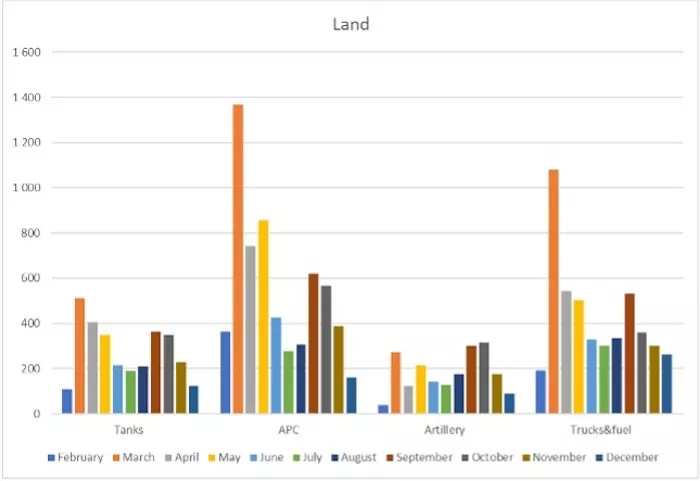
If the present trend continues, the Russian Armed Forces will have lost (KIA) 16,000 soldiers in December alone. This is the second-highest level of casualty in a month since the war started in 2014.
The loss of equipment, however, that being in the Air, on Land or at Sea, has fallen for two consecutive months. The expected number of tanks, artillery, MLRS, aircraft and helicopters, etc, lost in December is expected to be the lowest since the full-scale invasion started in February.
Ukraine will continue to surprise Russia and inspire the West. It will uphold and even intensify its attacks deep inside the Russian Federation.
Militarily, it makes sense. It has an impact on Russia's operational design. Attacking legitimate targets in Russia as a response to its unjustified, unprovoked war and its horrific attacks against the Ukrainian civil society brings the war closer to Russian society. As a consequence of an unpopular mobilisation, the lack of logistical support for the newly mobilised and the increasing number of casualties have had an impact on their support of the war and desire for negotiations. The fact that the war has also come closer, triggering massive defensive measures alongside the Ukrainian border, might also have had a psychological impact. If nothing else, it further highlights the shortcomings of the Russian Armed Forces and, therefore, the Russian strategic leadership.
The Ukrainian attacks have most definitely had a positive impact on the collective psyche in both Ukraine and the West. They have triggered both pride and awe.
The most important effect, however, is the impact on the Western calculus of the war itself. Ukraine has repeatedly crossed Putin’s red lines with impunity.
"The fear of escalation has changed since the beginning. It's different now. This is because the calculus of war has changed as a result of the suffering and brutality the Ukrainians are being subjected to by the Russians. Fears that Russia would launch a tactical nuclear strike or attack a member of NATO bordering Russia have subsided among US military planners, said The Times.”
Ukraine has learned from President Obama’s failure to uphold his “red lines” in Syria. It has challenged and forced President Putin to make the same mistake in Ukraine.
They have called the bluff and have been rewarded with an increased willingness to provide Ukraine with the tools it needs. I will not be surprised if we see the supply of increased long-range fire capabilities in the months to come.
300 days of surprises with more to come.

